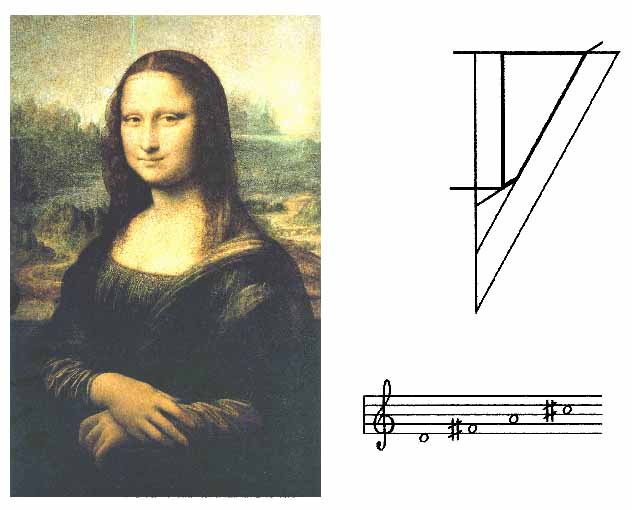|

|
|
Fig. 6.
Graphic intonations in Leonardo da Vinci's Gioconda.
Left: the original image.
Right: the directional structure of the face of
Mona Lisa comprises a E-major chord with a large seventh (bold).
|
Another historical parallel arises between the introduction
of the diminished-seventh chord in music and that of Cubism
in painting, both occurring at the beginning of this century.
The precise graphic analogue of the diminished seventh
(do—mi flat—sol flat—si
double flat) is a square, which has all the aesthetic
potential of the musical chord [31].
Now, let us turn to the mystery of color, which for a long
time had been a subject of abstract speculations and arduous
controversy. I distinguish two aspects of any perception:
perceptive quality and coloring. While quality determines
what the thing is, coloring refers to details that do not
carry the main idea of a composition and can be varied in
different ways [32]. To be strict, I should
point to a specific level of perception at which some components
of the whole image are considered significant, while others are
not. For instance, the instrumental cast for a musical piece
may vary freely, allowing for numerous arrangements; however,
in contrast to this potential for variation there is the
composer's arrangement, which may often be specifically
intended. In the same way, an artist may put his or her
intimate thoughts and high symbolism into the colors of a
painting, but a wider audience may well form opinions about
it on the basis of a black-and-white reproduction; these
opinions then occupy their own niche in the culture. On
the other hand, one cannot apply color without form, just
as there is no arrangement without something to be arranged.
Even the most abstract play of colors or modulations of
sound is somehow organized in space (or pitch) and this
organization still obeys the logic of scale hierarchies.
Naturally, there are cases when color cannot be detached
from painting without qualitative changes, e. g. the
landscapes of Claude Monet. By the same token, one cannot
imagine Ravel's Bolero outside its arrangement for
an orchestra. The links between impressionism in painting
and music deserve deeper consideration than I can give them
here. However, the principal idea of both is to shift
attention to coloring, to make it play the role of perceptive
logic. As a complement to the shift of coloring onto
logic, pitch-like relations become highly coloristic,
losing their qualitative aspect. However, they can never
lose it completely, since an observer perceives any
variation of color as a spatial form, and nothing can be
perceived by sight that is not spatially organized.
The role of color in visual arts is mainly to build forms
[33], just as the primary role of an
instrumental timbre in music is to mark a specific pitch.
As W. Kandinsky noted, the boundary of two colors produces
a form [34]. However, color is not
the only way to produce visual forms. The same effect can
also be obtained by light attenuation, sculptural
techniques, use of the plasticity of the human body in
choreography, etc. The variety of the visual arts comes
forth in this range of possibilities. But the common
feature of all visual arts is their basis in angle viewing,
implying hierarchies of directional scales.
Thus, there is a new language with which to speak of visual
arts: that of scale hierarchies. There is, however, no need
to measure angles when analyzing a painting, a sculpture,
a gesture, etc. A little training gives one a sense of visual
interval, just as we hear a musical fifth to be a fifth,
and so on. As soon as such a sense is developed, one is able
to appreciate the music of lines and discover a new world of
visual aesthetics.
Universal Scaling
I have demonstrated how pitch-like relations generate scale
hierarchies in both music and the visual arts. There are some
indications that the same process takes place in poetry, but
a more thorough investigation in this field is to be completed
later on. It is my belief that hierarchical scaling and the
potential for mathematical modeling that it allows provide us
with a universal means of analyzing art. The application of
the hierarchical approach to rhythm or nuances of performance
requires somewhat different mathematics, but the work is in
progress, and there is no doubt that some scaling phenomena
are to be discovered there as well. One may ask, therefore,
whether universal scaling in the arts displays only a peculiar
regularity of aesthetic perception or manifests a more general
law. I suppose that the grounds for aesthetic scaling are
rooted in the hierarchical nature of human activity in general,
which, in turn, reflects the inherent hierarchy of the world.
Any creative impulse springs from some refolding of that
hierarchy, and there is no purposeless art devoid of any
objective necessity. Art is one of the means of joining
individuals to society, and no artist creates anything
purely for the sake of creation without regard for the
opinions of potential observers. In any case, the artist
is the first judge of his or her work and, as such,
represents current societal attitudes. But any two
individuals (even if one of them is a clone of another)
can communicate only on the basis of some logic —
in other words, a mode of activity brought to them both
as a means of social regulation. Hierarchical scaling
in aesthetic perception provides an example of such community.
References and Notes